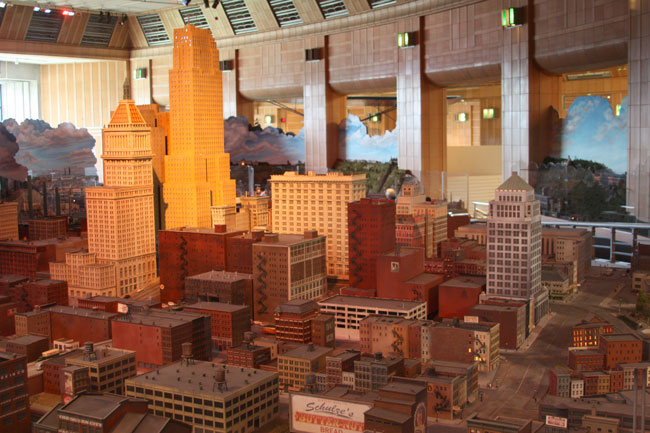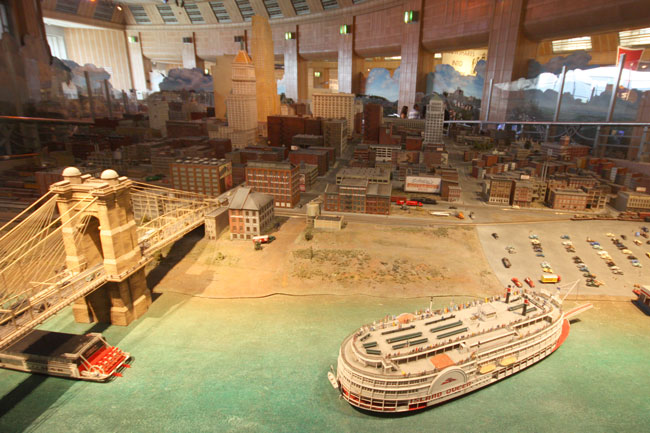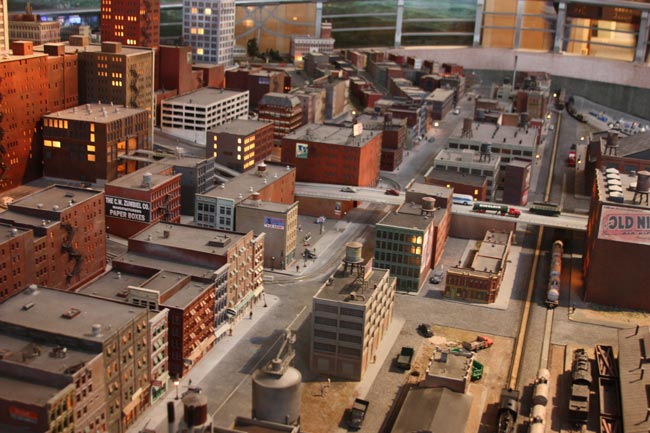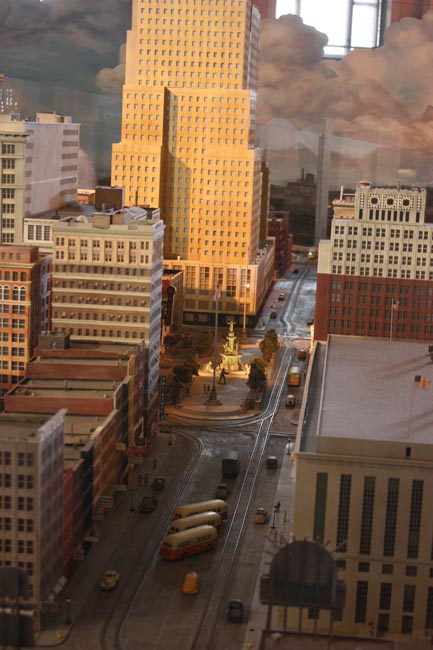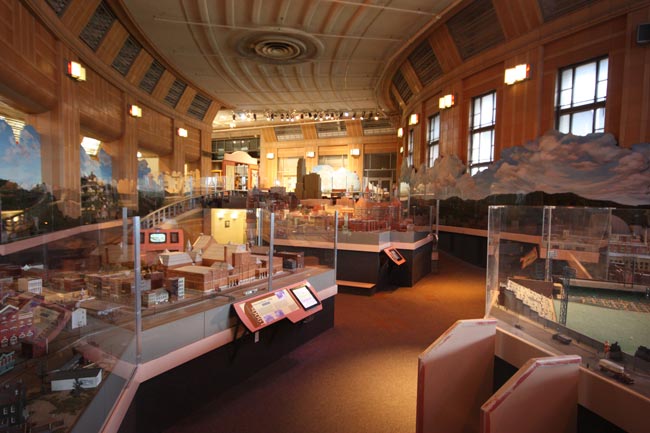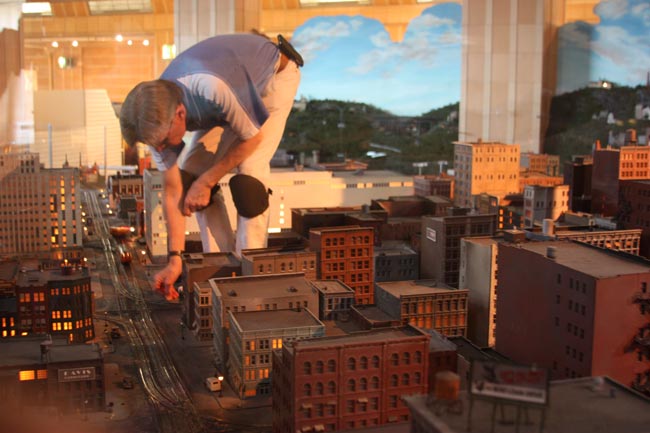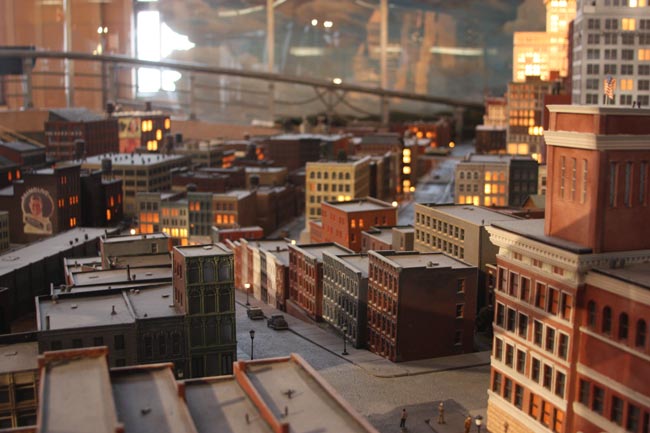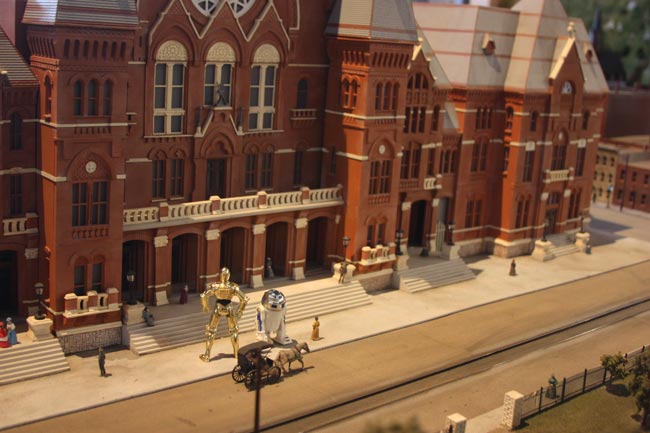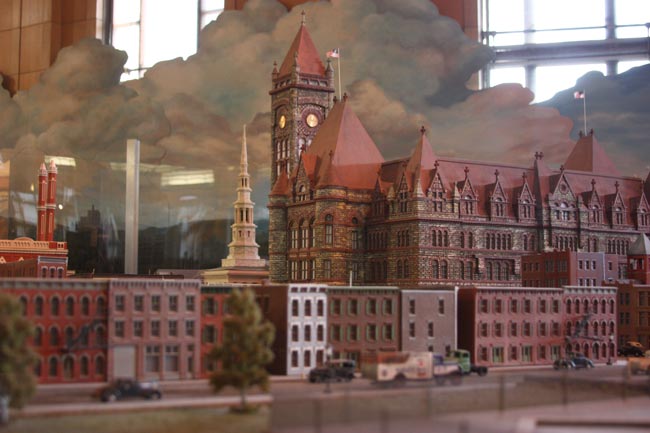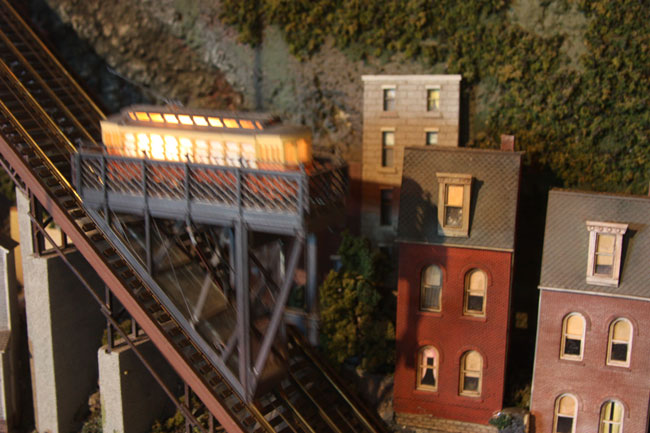|
The Cincinnati History Museum hosts a huge scale model of historical Cincinnati in 1940 covering over 2000 square feet. The museum is housed in the former auto coach terminal wing of the spectacular art deco Cincinnati Union Terminal train station. In keeping with the railway theme, the model is titled "Cincinnati in Motion" and features moving trains, streetcars, inclined railways and other animated elements. In fact, the model is one of the largest S-scale (1:64) train layouts ever built.
Cincinnati in Motion was designed by Clarke Dunham, a museum model railroad designer who started out designing Broadway theater sets. The model does have a bit of a theatrical presentation, as we look onto the city from above the Ohio River, the jumble of little riverbank warehouses rising up the hillside to a crescendo of early skyscrapers lit up by the rising sun of the cycling light system. At this scale the 49-story Carew Tower (1930) is about 8-feet 8-inches tall. Cass Gilbert's PNC Tower (1913) to its left rises over seven feet.
The model depicts the city in about 1940, the high-water mark of many American cities, before the postwar rise of suburbia, increasing power of the automobile, and urban renewal would change this view almost beyond recognition. For a brief period the old steamboat and the steel skyscraper shared this urban space, but soon all the traces of the industrial 19th-century riverbank which fueled the city's early growth, other than the 1867 Roebling suspension bridge at left, would be wiped away.
These brick warehouses and decaying factory buildings were demolished in the 1950s to build the sunken I-71 trench known as Fort Washington Way. An early twentieth-century postcard and 1920s aerial photo of the area shows that it was more crowded with industrial buildings than the model depicts. Like many railroad model layouts, the miniature streets are wider than true scale to allow for passage for the moving trolleys. A Cincinnati Enquirer article explains that some areas of the model have been "abridged" by eliminating a few streets and condensing the blocks of smaller industrial buildings. The buildings have not been edited as much as The Great Train Story model at Chicago's Museum of Science and Industry, but its too bad this area of the model is not fully accurate, as it would be interesting to visualize the full extent of this picturesque section of the city which is now vanished.
The model is full of charming views, like this glimpse into Fountain Square at the base of the Carew Tower. A tiny video camera hidden in one of the buildings also gives you a closer view of the comings and goings of little trolley cars around the square.
From the first overlook of the dramatic downtown skyline, ramps wind around each side of the model and down to a lower level of smaller sections depicting neighborhood landmarks. The same connected train tracks meander through all of these models, but they are separate scenes not really in spatial relationship with the downtown area.
Now and then, a monstrous Gulliver appears out of a hole in the ground to snatch a malfunctioning trolley off the tracks.
The industrial buildings on this diagonal street are more likely to be stock railroad facades rather than exact reproductions of the real structures which once stood here, as described in the 1999 Enquirer article. Note the period automobiles and pedestrians: the large scale of the city model allows for a lot of detail creating little stories and scenes. There are over 1500 tiny people in the downtown area. On the outskirts of the city a boy flies a toy airplane in circles. In the Over The Rhine neighborhood a German marching band practices for a parade. In some places the builders even modelled shop window display interiors from vintage photographs.
These little "easter eggs" are a common trope of railroad layout models. But the museum staff here go even farther and periodically hide toys in the model for children to find who are perhaps bored of the architecture and trains. As we happened to visit on "Star Wars Day," there are alien visitors in front of the 1878 Cincinnati Music Hall.
Some old parts of the city survive to this day, including the thin towers of the 1866 Isaac Wise Temple on the left in the photo, the stepped tower of the 1845 St. Peter in Chains Cathedral and the massive Romanesque pile of the 1882 City Hall.
Around the edges of the model are flattened diorama-like animated models of the five picturesque incline railways which once allowed wagons and later streetcars to ascend the steep hills to neighborhoods surrounding downtown. Unlike typical funicular railroad cars which carry only passengers, Cincinnati's inclines carried entire streetcars and automobiles which then continued on their way at the top or bottom of the hills. The last of these unique contraptions, the Mount Adams Incline, was demolished in 1948. Visit other mini cities around the world |








